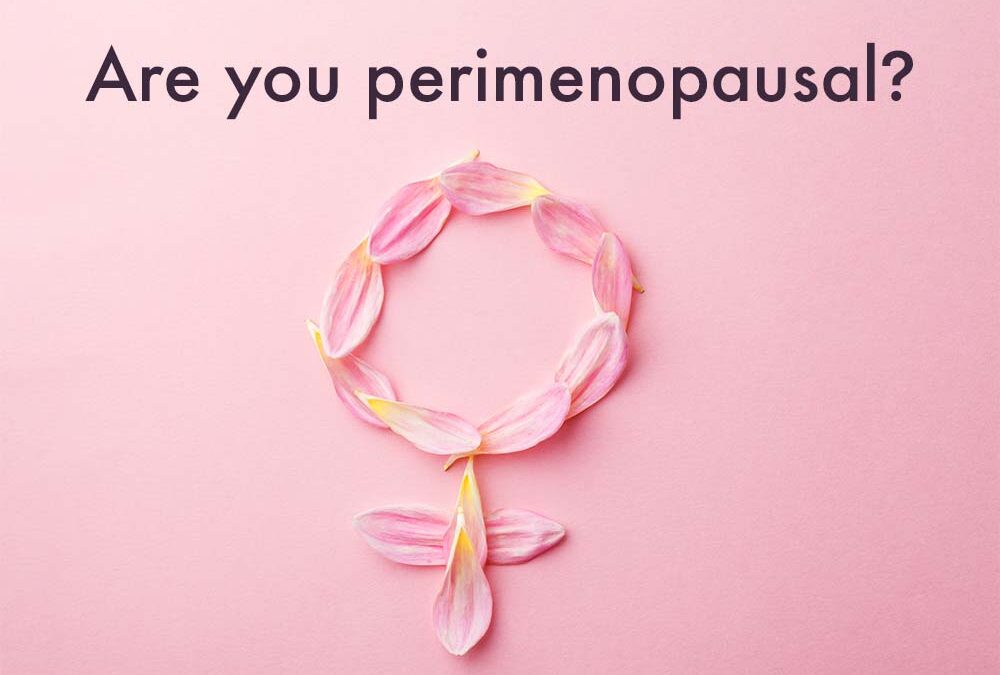Are you entering the perimenopause stage?
The perimenopause can be one of the trickiest times for women to get their head around. One minute you’re 30, full of energy to do all the things you want in your life. Yes, there may be challenges but none of them seem unmanageable.
Life – especially when you look back – seemed pretty great. All of a sudden it seems life and age have snuck up on you. You’re just not quite the same person you used to be. You notice you get tired more easily, some days you’re literally dragging yourself through the day, you’ve lost your get up and go for no reason, the weight you used to be able to lose in the run-up to an important event stays stubbornly in place no matter what you try, and you can’t seem to shift that foggy feeling in your brain. But it can’t be the menopause, right? You’re too young…
What is the peri-menopause?
The menopause actually refers to a time when you haven’t had a single period for at least a year. The run-up to it can last for years and it’s called the peri-menopause. Think of it as the menopause transition. It can take eight to ten years! Women typically start to experience it in their 40s – and often the most obvious signs are that your periods go a little crazy – though for some it can even start in their 30s.
In the perimenopause, levels of one of the main female sex hormones, oestrogen, rises and falls unevenly. The length of time between periods may be longer or shorter, your flow may be light to really heavy and with worse PMS than ever before, and you may even skip some periods – before they come back with a vengeance.
You might also experience some of the symptoms traditionally associated with the menopause, like night sweats, hot flushes, sleep problems, mood swings, more UTIs like cystitis and vaginal dryness. Around this time, you might begin to notice that weight loss becomes trickier and your digestion gets a little shaky.
Symptoms
The way some talk about the perimenopause, you’d think it was a disease. There’s no need to go to your doctor to get an official diagnosis – although it’s definitely worth booking and appointment, if you notice any of these specific symptoms, as they can point to other problems and it’s always better to be safe than sorry. Fibroids are something very common at this time.
- spotting after your period
- blood clots during your period
- bleeding after sex
- periods that are much longer or much shorter than normal
If you are really struggling with your energy levels, it’s also worth getting your thyroid checked, if it hasn’t already been because perimenopausal and menopausal women are at greater risk of thyroid dysfunction. Added to this, thyroid symptoms can mimic menopausal symptoms. The ovaries, uterus, adrenal glands and the brain require adequate thyroid hormones to function.
What you should do
Whatever your specific symptoms are, a tailored nutrition plan can really help. I know you could search the web for ‘diet for perimenopause’, but the truth is – and I know this from working with many clients dealing with symptoms – the answer lies not in fixing yourself symptom by symptom. In the human body everything is connected in ways you might not imagine. Looking at the whole of you rather than individual complaints is the way forward.
I work with women who have had enough of dealing with feeling a shadow of the person they used to know and love and really help them regain their lost energy and focus. Maintaining a stable blood sugar level can help. So give this a try:
- Eat three meals a day at regular intervals.
- Eat a palm-sized portion of protein at each meal (meat and poultry, fish and seafood, tofu, eggs, beans, lentils, chickpeas, nuts and seeds – ideally nothing in batter or breadcrumbs).
- Don’t worry about healthy fats, like olive oil and avocados (the calories in vs calories out myth has been debunked now for a while).
- Eat a minimum of five portions (three heaped tablespoons) of non-starchy vegetables or salad every day. Always have vegetables or salad with lunch and dinner. There is no upper limit on how many vegetables you can eat. The ideal options are anything that grows above ground.
- Eat two portions of low glycaemic fruit per day, with meals – bananas are high in sugar, so try to stick to berries of any kind, apples, pears, plums, tangerines or similar, lemon and lime, peaches and nectarines.
- Ideally you should feel satisfied from your main meals and not require snacks though the day, however, should you feel hungry or if you are working out, you can have one snack per day – something like oatcakes with cream cheese, hummus, cottage cheese, ham and tomato, a small pot of natural yoghurt with berries, a Bounce ball, a handful of nuts and/or seeds, a matchbox-sized chunk of cheese with an apple, cut up apple and unsweetened nut butter.
You would be amazed the difference a really good sleep can have on symptoms as it helps managing stress levels.
On both counts, Epsom salt baths deliver amazing results. You’ll also want to put in place a proper sleep plan that limits screen time at least one hour before bed, has some wind-down time, involves a dark room (or eye mask).
Your next step
I know that changing habits is a process that is not overnight or easy, so don’t take on too much at once.
I am a huge advocate of step by step change so that habits really become part of your life. Be kind to yourself and approach each of my tips individually and don’t forget to celebrate your success.

